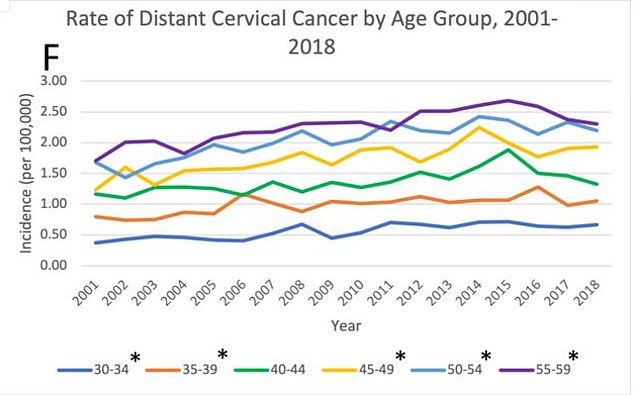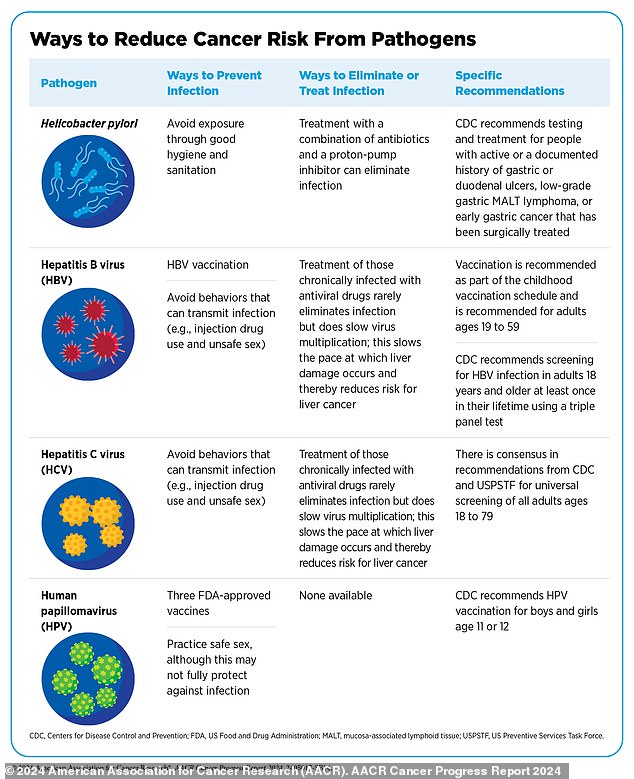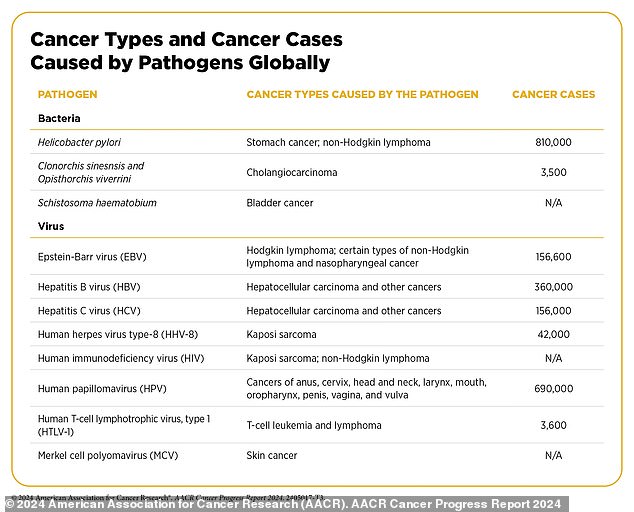Oncologists warn of increase in cancers you can ‘CATCH’






Cancer is generally not seen as a disease that people can ‘catch’.
But a new report warns that tumors caused by common sexually transmitted diseases are on the rise across America.
Although rates of serious lung, breast and kidney cancer have remained stable in recent years, certain types of cancer associated with the human papillomavirus (HPV) are showing an adverse trend.
A new report from the American Association for Cancer Research found that cervical cancer in people ages 30 to 34 increased by 17.5 percent between 2012 and 2019.
The number of cases of mouth and throat cancer caused by HPV is also increasing across all age groups, the AACR report said.


Michael Douglas shared his HPV and throat cancer story on the Graham Norton show in 2013. He has been in remission ever since. Farrah Fawcett set up a foundation to fund research into HPV-related cancers and help prevent others from getting the disease that took her life in 2006

The AACR report cites a 2022 study from the International Journal of Gynecological Cancer, which found that rates of cervical cancer in people under 45 have increased since the early 2010s.
The report pins the rise on people avoiding the vaccine. Other theories include more people having casual, unprotected sex.
For girls and boys, it is recommended to start the three-vaccination course around the age of 11 years.
But the vaccine has not yet been made mandatory nationwide, and the US lags behind other countries in its adoption.
In 2022, only 38 percent of US adolescents had received at least one dose of the HPV vaccine.
In the United Kingdom and Australia, 76 percent and 84 percent of children under 17 had received one or more doses of the vaccine, respectively.
“Despite clear evidence that the vaccine reduces the incidence of cervical cancer, vaccination rates in the US are low,” the report said.
“These data highlight the critical importance of public health measures to promote the prevention and early detection of cervical cancer in the United States.”
“By dedicating resources to raising public awareness of cancer prevention…we can accelerate progress in reducing the global burden of cancer.”
The report estimates that approximately 2 million cases of cancer will be diagnosed in the US in 2024.
According to the American Cancer Society, HPV-related cancers — of the mouth, head, throat, cervix and genitals — account for 1.2 percent of all cancers in men and 2.5 percent of all cancers in women.
This represents approximately 11,500 new cases of cervical cancer and approximately 4,000 dead from the disease.
The AACR report found that among women aged 30 to 34, the overall incidence of cervical cancer increased by 2.5 percent per year between 2012 and 2019, for a total of 17.5 percent over seven years.
According to the AACR, the number of oral cancers linked to HPV, both of the throat and mouth, is increasing across all age groups.
The American Cancer Society It is estimated that since the mid-2000s, the number of cases of mouth and throat cancer has increased by 1 percent per year, mainly due to HPV.
Some doctors think that oral sex – in any form – could be the culprit.
There is some evidence that the increase in HPV-related cancers is associated with riskier sexual behavior among people seeking contact after the pandemic.

HPV is a highly contagious sexually transmitted infection that is thought to be responsible for about 1.2 percent of cancers in men and 2.5 percent of cancers in women in the U.S. each year. It is associated with cervical, head, neck, throat, and anal cancers
Public health officials and pop culture icons have called attention to this trend in recent years.
Michael Douglas reported in 2013 that he believed he had developed throat cancer from the HPV virus he contracted during oral sex.
Charlie’s Angels star Farah Fawcett died in 2006 from a form of cancer caused by HPV. Before her death, she set up a program at UC Davis to raise awareness for the disease.
HPV is a virus that can be transmitted through contact with the blood, bodily fluids, or skin of an infected person, primarily through sex.
It is highly contagious and according to the National Foundation for Infectious DiseasesIt is thought to affect more than 42 million Americans.

There are many different pathogens that have been linked to cancer. Some, like HPV and hepatitis, are viruses. Others, like H. Pylori, the bacteria also thought to cause ulcers, are bacteria. These cancers fluctuate in different parts of the world based on hygiene and medical practices.
There are 200 different types of HPV infections, twelve of which are associated with cancer.
The virus can cause cancer by weakening the immune system, causing chronic inflammation and changing the behavior of cells in the body, causing them to mutate into cancer cells.
Nearly 99.7 percent of all cervical cancers are caused by HPV.
According to the AACR report, about 90 percent of anal cancers, 70 percent of mouth and throat cancers, and many penile and vulvar cancers are caused by this virus.
In 2006, the FDA approved a vaccine against HPV. It is available for both boys and girls from the age of 11.
According to a study from the University of Illinois in the United States, vaccination is believed to prevent almost nine out of ten HPV-associated cancers. Research from Sweden from 2020A 2024 study in Scotland also found that early vaccination programmes started decades earlier have led to zero new cases of cervical cancer this year.




